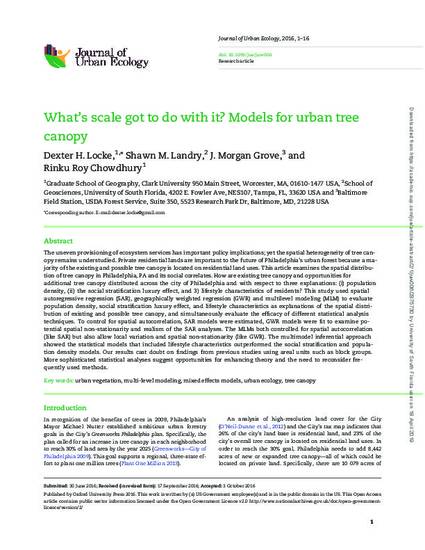
- urban vegetation,
- multi-level modeling,
- mixed effects models,
- urban ecology,
- tree canopy
The uneven provisioning of ecosystem services has important policy implications; yet the spatial heterogeneity of tree canopy remains understudied. Private residential lands are important to the future of Philadelphia’s urban forest because a majority of the existing and possible tree canopy is located on residential land uses. This article examines the spatial distribution of tree canopy in Philadelphia, PA and its social correlates. How are existing tree canopy and opportunities for additional tree canopy distributed across the city of Philadelphia and with respect to three explanations: (i) population density, (ii) the social stratification luxury effect, and 3) lifestyle characteristics of residents? This study used spatial autoregressive regression (SAR), geographically weighted regression (GWR) and multilevel modeling (MLM) to evaluate population density, social stratification luxury effect, and lifestyle characteristics as explanations of the spatial distribution of existing and possible tree canopy, and simultaneously evaluate the efficacy of different statistical analysis techniques. To control for spatial autocorrelation, SAR models were estimated, GWR models were fit to examine potential spatial non-stationarity and realism of the SAR analyses. The MLMs both controlled for spatial autocorrelation (like SAR) but also allow local variation and spatial non-stationarity (like GWR). The multimodel inferential approach showed the statistical models that included lifestyle characteristics outperformed the social stratification and population density models. Our results cast doubt on findings from previous studies using areal units such as block groups. More sophisticated statistical analyses suggest opportunities for enhancing theory and the need to reconsider frequently used methods.
Journal of Urban Ecology, v. 2, issue 1, art. 6
Published by Oxford University Press 2016. This work is written by (a) US Government employee(s) and is in the public domain in the US. This Open Access article contains public sector information licensed under the Open Government Licence v2.0 http://www.nationalarchives.gov.uk/doc/open-government-licence/version/2/
Available at: http://works.bepress.com/shawn-landry/26/